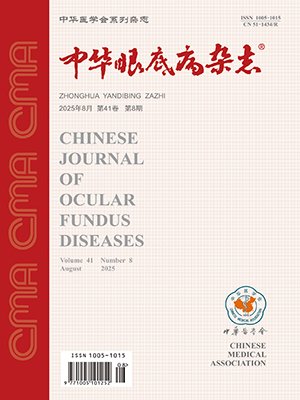| 1. |
Takano M, Kishi S. Foveal retinoschisis and retinal detachment in severely myopic eyes with posterior staphyloma[J]. Am J Ophthalmol, 1999, 128(4): 472-476.
|
| 2. |
Phillips CI. Retinal detachment at the posterior pole[J]. Br J Ophthalmol, 1958, 42(12): 749-753.
|
| 3. |
Benhamou N, Massin P, Haouchine B, et al. Macular retinoschisis in highly myopic eyes[J]. Am J Ophthalmol, 2002, 133(6): 794-800.
|
| 4. |
Kanda S, Uemura A, Sakamoto Y, et al. Vitrectomy with internal limiting membrane peeling for macular retinoschisis and retinal detachment without macular hole in highly myopic eyes[J]. Am J Ophthalmol, 2003, 136(1): 177-180.
|
| 5. |
Qi Y, Duan AL, You QS, et al. Posterior scleral reinforcement and vitrectomy for myopic foveoschisis in extreme myopia[J]. Retina, 2015, 35(2): 351-357.
|
| 6. |
孙敏, 孙吉君, 宋宗明. 玻璃体视网膜手术治疗病理性近视黄斑劈裂的疗效观察及视力预后影响因素分析[J]. 中华眼底病杂志, 2012, 28(2): 117-120.
|
| 7. |
Baba T, Tanaka S, Maesawa A, et al. Scleral buckling with macular plombe for eyes with myopic macular retinoschisis and retinal detachment without macular hole[J]. Am J Ophthalmol, 2006, 142(3): 483-487.
|
| 8. |
Wu PC, Chen YJ, Chen YH, et al. Factors associated with foveoschisis and foveal detachment without macular hole in high myopia[J]. Eye (Lond), 2009, 23(2): 356-361.
|
| 9. |
Zhu Z, Ji X, Zhang J, et al. Posterior scleral reinforcement in the treatment of macular retinoschisis in highly myopic patients[J]. Clin Experiment Ophthalmol, 2009, 37(7): 660-663.
|
| 10. |
Holladay JT. Proper method for calculating average visual acuity[J]. J Refract Surg, 1997, 13(4): 388-391.
|
| 11. |
张娅萍, 薛安全, 王毓琴, 等. 非内界膜剥离的玻璃体切除术对病理性近视黄斑劈裂疗效的临床研究[J]. 中华眼科杂志, 2011, 47(6): 497-503.
|
| 12. |
Taban M, Sharma S, Williams DR, et al. Comparing retinal thickness measurements using automated fast macular thickness map versus six-radial line scans with manual measurements[J]. Ophthalmology, 2009, 116(5): 964-970.
|
| 13. |
Ikuno Y, Gomi F, Tano Y. Potent retinal arteriolar traction as a possible cause of myopic foveoschisis[J]. Am J Ophthalmol, 2005, 139(3): 462-467.
|
| 14. |
Xue A, Bao F, Zheng L, et al. Posterior scleral reinforcement on progressive high myopic young patients[J]. Optom Vis Sci, 2014, 91(4): 412-418.
|
| 15. |
朱双倩, 王勤美, 郑林燕, 等. 后巩膜加固术治疗病理性近视黄斑劈裂[J]. 中华眼视光学与视觉科学杂志, 2014, 16(3):177-180.
|
| 16. |
Shimada N, Ohno-Matsui K, Yoshida T, et al. Progression from macular retinoschisis to retinal detachment in highly myopic eyes is associated with outer lamellar hole formation[J]. Br J Ophthalmol, 2008, 92(6): 762-764.
|




